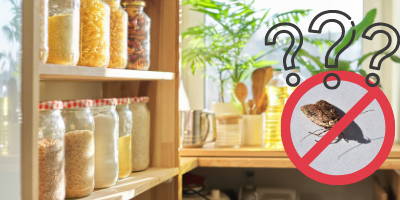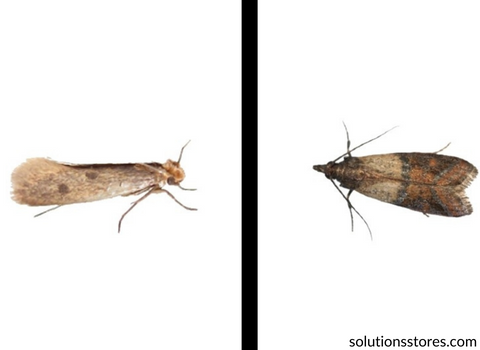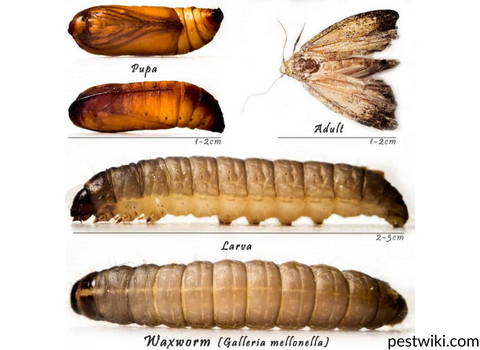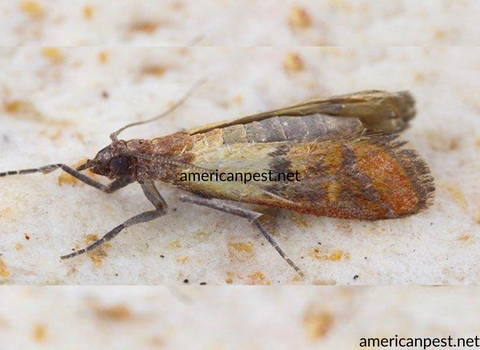Do Pantry Moths Eat Clothes?
Clothes moths and pantry moths can infest homes and cause a lot of damage. So, if you are dealing with a moth infestation, continue reading to see how you can get rid of them.
Clothes Moths vs Pantry Moths
What do clothes and pantry moths look like? There are two kinds of clothes moths – the case making moths (Tinea pellionella) and webbing clothes moths (Tineola bisselliella). Adult clothes moths are ½-inch long and have narrow and hairy wings.
The webbing clothes moth is whitish-gold and has a bunch of red hairs on its head. Larvae have a dark brown head. Clothes moths are rarely seen as they always avoid light. They are occasionally mistaken for pantry moths, which are a bit different in colour.
Pantry moths, also known as Indian meal moths, are approximately ½-inch long. They have tapered grey wings. Two-thirds of their wings are reddish-brown with black striping. Larvae have 5 sets of prolegs jutting from the abdomen and 3 leg sets near the head.
If you see pantry moths flying around the pantry or kitchen, that is a sign that you have a moth infestation at home. Indian meal moth larvae are also approximately ½-inch, but they are off-white. They spin silky webs when they burrow into dry food containers.
Pantry Moth Diet
Pantry moths will infest and burrow into stored food like cornmeal, oatmeal, grain rice, nuts, flour, cereal, and flour. They also eat birdseed, dried fruits, dry pasta, and pet food.
Clothes Moth Diet
Clothes moths love the natural fibres in clothes like wool, silk, and cotton as well as upholstery, bedding, carpet, drapes, or curtains. They can also eat through any synthetic materials to look for natural fibres that are hidden inside.
Life Cycle of Pantry Moths
Pantry moths go through metamorphosis and produce prolifically. Females can lay 400 eggs near or on food sources. The eggs usually hatch within a week, but they may hatch faster if the environment is warm. Pantry moth larvae can cause some damage to stored food items. This may last for 2-3 months until they reach the pupal stage.
You can find pantry moth cocoons in crevices and cracks or stored food. After another 2-4 weeks, the pupa will emerge as adult pantry moths and the cycle will begin all over again. Reddish-brown adult moths are attracted to lights. They also fly around to look for a potential mate. When this happens, a few moths can cause a full-on infestation within a short time.
Life Cycle of Clothes Moth
Clothes moths go through a metamorphosis as well. The average life cycle of clothes moths is 60-90 days. Female clothes moths are capable of laying around 50 eggs. After mating with male moths, female moths lay their eggs on suitable fabrics like wool fur and cashmere. The eggs hatch after 4-10 days.
They hatch faster in warm environments. Cool temperatures prevent or delay hatching. Moth larvae can live between 35 days and 2 ½ years. Once they have eaten enough fibres, they pupate. In unheated buildings or cold climates, pupation may take around 4 months, while in regular temperatures, it may occur in around 8-10 days.
How to Tell What Kind of Infestation You are Dealing With
A pantry moth infestation is more noticeable than a clothes moth infestation. Pantry moth larvae will spin a web around themselves when they eat or burrow through your food items. Thus, you will see “caterpillars” and webbing in the food. After they pupate, you will see adult pantry moths flying around.
Clothes moths are more difficult to find than pantry months, but adults will not usually go far from the food source. Eggs and larvae, however, are more difficult to find. You may not even notice that you have them in your home until you see holes in your clothes.
It is not easy to get rid of pantry and clothes moths once they invade your home. That is why you need to be alert, so you can take action immediately and prevent them from spreading. Do not worry because there are a lot of ways to eliminate pantry and clothes moths. And if you cannot handle them on your own, you can always hire a pest control company to control them for you.

How to Eliminate Pantry Moths
The best way to get rid of pantry moths is to take action immediately once you spot an infestation. Here are some tips on how to eliminate pantry moths.
If you find an infested food package, place the package in a plastic bag then seal it. Discard the plastic bag in the trash.
Remove all food items from the pantry and cabinets then check for any signs of infestation. Throw away contaminated products.
You should also remove and throw away any shelf-liner paper from the kitchen cabinets or pantry because there might be larvae hiding underneath the paper. Do not forget to place the paper in plastic bags then discard them in the trash.
You should also vacuum your cabinet shelves and pantry. The vacuum cleaner bag should be emptied into the trash after cleaning the shelves.
You also need to wash the pantry shelves, floor, walls, and door with hot water and soap. Pantry moths can hide behind the fridge, on top of your cabinets, or even in the corners of the pantry ceiling, so do not forget to clean and vacuum all potentially infested places.
Once the shelves and cabinets are dry, place a new shelf-liner paper then replace the containers or food items that you have taken out. Place your food in airtight containers.
You can also place moth traps around food sources. These traps can contain moths that you have missed. Moth traps are non-toxic and can last for up to 3 months.
Below are some products we recommend and that you can use in getting rid of pantry moths:
How to Eliminate Clothes Moths
If you have discovered moths in your cabinets, do not worry because there are different ways to get rid of them. One of the most important things that you need to keep in mind is to wash your clothes and household items with hot water and soap.
Washing your clothes at 120⁰ Fahrenheit for 20-30 minutes will kill adult clothes moths as well as eggs and larvae. Cold temperatures can also kill moths. Place fabrics and garments in airtight freezer bags and keep them at 18⁰ Fahrenheit for several days. You can fumigate garments with dry ice as well.
Mothballs can also kill clothes moths. It contains paradichlorobenzene or 1,4-dichlorobenzene, which suffocates adult moths and larvae. You can also use moth traps. Another way to get rid of moths is by brushing and exposing the infested items to sunlight for several hours.
For severe moth infestations, remove all clothes and items from your closet. Wash your clothes in hot water and soap for at least 30 minutes to kill any hidden larvae and eggs. Air your clothes in bright sunlight before placing them back in your closet.
Conclusion
Pantry moths do not eat clothes because their diet is different from clothes moths. That is why you need to identify what kind of moth you are dealing with, so you can use the right method to eliminate them. But whether you are dealing with pantry moths or clothes moths, you have to get rid of them immediately to prevent them from causing a lot of damage to your home.




